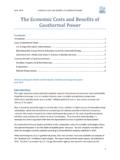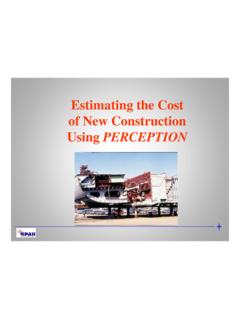Transcription of Guide to Elemental Cost Estimating & Analysis for …
1 Guide to Elemental cost Estimating & Analysis for Building Works 2013 No responsibility for loss or damage caused to any person acting or refraining from action as a result of the material contained in this Guide can be accepted by the Africa Association of Quantity Surveyors 1 CONTENTS Table of Contents Page 1. FOREWORD .. 3 2. INTRODUCTION .. 4 3. PURPOSE OF Elemental cost Estimating .. 5 4. LIST OF SECTIONS, ELEMENTS AND COMPONENTS .. 9 5. DEFINITIONS .. 20 6. SALIENT FEATURES OF THIS Guide .. 23 7. SCHEDULE OF ELEMENTS / COMPONENTS .. 25 8. EXAMPLES .. 102 9. INDEX .. 109 2 1. FOREWORD In 1998 the Association of South African Quantity Surveyors published the second edition of the Guide to Elemental cost Estimating & Analysis for Building Works.
2 An amended version was issued by the Africa Association of Quantity Surveyors during 2003. This Guide replaces both A committee comprising Patrick Waterson and Andrew Koen under the chairmanship of Martin Smith was established at the beginning of 2012 to examine whether there was a need to revise and possibly expand the 1998 and 2003 editions to accommodate changes that have taken place in the industry since those versions were published The committee endeavoured to refine the principles established in the previous editions by incorporating international advances in the industry to better Guide quantity surveyors active in Africa and further afield Invaluable insight was gleaned, and is herewith acknowledged, from publications such as RICS new rules of measurement.
3 Order of cost Estimating and Elemental cost planning (February 2009), Measurement of Buildings by Area and Volume (Canadian Institute of Quantity Surveyors), UNIFORMAT II published by the National Institute of Standards and Technology (NIST) and the American Society of Testing and Materials (ASTM) and Uniformat published by The Construction Specifications Institute (CSI) in the United States of America and Construction Specifications Canada (CSC) The Services and Model Documentation Board of the Africa Association of Quantity Surveyors comprising Corn de Leeuw (chairman) (South Africa), Michael Frimpong (Ghana), Dan Kimoro (Kenya) and Segun Ajamlekoko (Nigeria) also provided input 3 2. INTRODUCTION The Elemental method is an approach towards calculating the total estimated cost of construction projects.
4 It considers the major elements of a building and, if properly implemented, provides a cost estimate based on an Elemental breakdown of the building project To achieve this goal the measurement and descriptions of building works for estimates should be consistent. By ensuring that different building projects are measured and described in the same manner, the data from one can be meaningfully applied to another. A lack of consistency makes it extremely difficult for the employer and project team to comprehend what is included in the cost estimate, cost limit or cost target, often casting doubt about the cost advice provided This Guide presents a system which sets out principles and a model format for Elemental cost Estimating which may be understood by all those involved in construction projects thereby aiding communication between the design team and the employer.
5 It provides a structured basis for measuring building work and advances a consistent approach for dealing with other key cost components associated with a building project. It should also assist the quantity surveyor in providing effective and reliable cost advice The primary objective of this Guide is to present a system which sets out principles and a model format for Elemental Estimating . It is not the intention to explain alternative Estimating methods, procurement methods or contract strategies This Guide is not intended to classify elements of major civil works. Buildings, however, are usually accompanied by roads, utilities, parking areas, and other non-building features. The building element External works and services is provided in order that users do not have to resort to multiple Elemental classifications for what is primarily a building project 4 3.
6 PURPOSE OF Elemental cost Estimating General Elemental cost Estimating and Analysis is one of a number of alternative Estimating methods. In any Estimating method the fewer quantities which are measured the more difficult it is to price. During the design development stages of a development, at which time only minimal information is available, the measurement should be simplified as far as possible. A square metre estimate is easy to compile but to some extent less reliable whilst a detailed quantity take-off is more reliable but time consuming. The Elemental method is a compromise between the relatively easy and quick square metre method and the more cumbersome and detailed quantity take-off The primary purpose of an Elemental cost Analysis is to enable cost information to be collated and produced in a manner which can assist in the cost controlling of future building projects.
7 A standard set of building elements and components are a prerequisite. cost control is achieved by preparing an estimate of construction cost based on the information gleaned from this Analysis in the very early stages of a development, when little or no design information is available The need for an Elemental classification is most apparent in the economic evaluation of building alternatives at the design stage. cost estimates using a format based on a detailed measurement are time consuming, costly and inappropriate at the early design stages By ensuring that Elemental estimates are measured in the same manner the cost data can meaningfully be applied to other building projects. Using this Guide ensures consistency in the economic evaluation of building projects over time and from project to project.
8 The estimator is therefore urged not to deviate from the system proposed in this Guide since only then will it be possible to use the derived data for comparative Elemental Estimating The amount of detail to be measured for each element is related to the cost significance of the element in the particular design. Where sufficient information is available expensive items are to be measured in detail. Composite items are measured by combining or grouping together items to common forms of measurement Unit rates are applied to each of the Elemental quantities. The rates should be inclusive of all materials, labour and plant that are specifically required to construct the element and any subcontractors preliminaries, design fees, contingency allowances and overheads and profit.
9 Unit rates are to exclude main contractor s preliminaries and other allowances, such as development design team fees, other development costs, contingency allowances and escalation. These items are to be assessed separately and added to the estimate When using unit rates from cost analyses and benchmark analyses, care should be taken to ensure that such rates have been adjusted to reflect prices current at the time the estimate is prepared (ie adjusted to remove allowances included for construction escalation), location and unique design features cost control is achieved by compiling an estimate based on the information contained in the Analysis throughout the various development stages of a development. A major benefit of performing an economic Analysis based on an Elemental classification is the reduction in 5 time and costs for evaluating alternatives at the early design stage when economic Analysis is most important in establishing the most efficient choices between building alternatives Benefits of Elemental cost Estimating Some of the benefits from using this Guide to structure estimates are the following: 1.
10 Composite Elemental costs are used for early design estimates, thereby eliminating the time-consuming and costly exercise of identifying, quantifying and costing material and labour for each product 2. Elemental rates communicate the quality level of elements. Elemental estimates can therefore be initially prepared based on the anticipated quality level of a building project without knowing the specific products that make up the elements 3. Elemental estimates provide a more realistic distribution of costs for assigning design-to- cost targets for each discipline than do arbitrary percentage allocations that do not necessarily reflect program requirements or anticipated quality levels 4. Elemental costs can be monitored, element by element, from the programming phase through the final design phase, making it easier to document the "audit trail" required in quality management programs 5.






